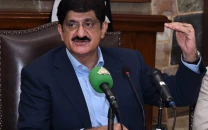Vehicles are city’s worst offenders
Country’s most populated city is missing emissions testing systems, government-owned air quality monitors
1658648281-0/images-karachi2(7)1658648281-0-640x480.webp)
Not only is the headcount growing at rapid speed in Karachi but the traffic count has seen a drastic upsurge as well. Consequently, drivers trading insults due to choked roads and more importantly, hazardous air, have become the norm.
Environmentalists are of the view that apart from a lack of green spaces, vehicular emissions in the city are a major source of air pollution.
The air quality index (AQI) readings of Karachi have consistently been above 150, which is considered as unhealthy air, during the past week and have even topped 200, considered as hazardous air, on some days. Furthermore, when the city’s air is unhealthy, the fine particulate matter (PM 2.5), rises to roughly 16.8 times higher than the World Health Organisation’s (WHO) annual air quality guideline value.
“Around 50 to 60 per cent of the total air pollution of the city is caused by vehicular traffic,” remarked Yasir Hussain, an environmental expert based in the city. Nasir Panwhar, another environmentalist, concurring with Hussain, said that the growing number of vehicles on roads, a lack of road maintenance and repair, and the absence of a solid waste management system adds to the city’s air quality woes.
Since both environmentalists pointed out an increase in vehicles as the main cause behind the city’s hazardous air, the Express Tribune, inquired from the Motor Vehicles Registration Wing of the provincial Excise and Taxation Department, as to how many vehicles ply the city’s roads. “Around half a million, automobiles and motorcycles, are added to Karachi’s traffic count every year,” informed Syed Ziauddin Shah, who’s in-charge of the registration wing. Sharing the latest figures of newly registered vehicles with the Express Tribune, Shah said that at least 115,236 commercial and private vehicles and 322,985 motorcycles were registered in Karachi during an eleven month period from November 2021 to September of this year. Since the city has registered more than 438,000 vehicles in the past 11 months, the Express Tribune asked the traffic department whether they had any emission testing system in place to fine cars and bikes which emit toxic smoke.
“The traffic department does not have any mechanism for emission testing,” answered Deputy Inspector General (DIG) Traffic, Ahmed Nawaz. However, as per Nawaz, the traffic police, according to the relevant law, regularly fines vehicles emitting toxic smoke. “We also assist the provincial environment department in its drive against such vehicles,” the DIG said. The lack of emission testing systems is only one side of the coin, the Express Tribune learnt from sources in the Sindh Environmental Protection Agency (SEPA), which is responsible for monitoring the city’s air quality, that the agency does not have any equipment to monitor air quality.
As per the official, who requested anonymity, the agency relies on equipment set up by non-governmental organisations (NGOs) and private individuals to assess the air quality. “It had established two air quality monitoring stations a few years back, one on the roof of its head office in Korangi and another on the roof of DC Central’s office. However, both of these have become non-functional due to a lack of maintenance,” the SEPA official confided to The Express Tribune.
Published in The Express Tribune, November 14th, 2022



















COMMENTS
Comments are moderated and generally will be posted if they are on-topic and not abusive.
For more information, please see our Comments FAQ